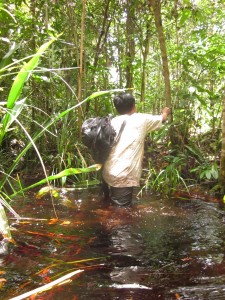Innovative Ideas for Forest Management in Indonesia
By Peter Newton
We are standing in knee-deep, tea-colored water. “Pekerjaan kami di sini”, smiles Pak Tukul, “our work is here”. He and his colleague Pak Maryanto have led my colleague Lini and me to this spot in the flooded peat-swamp forest, wading through pools and clambering across roots and over fallen trunks. We are here to see a research plot where they have been working.
Why all the hard work? The site is part of an innovative REDD-like project, covering a vast 204,000 hectare (Mauritius-sized) tract of forest in Central Kalimantan, just east of the regional capital of Sampit. Formerly a licensed logging concession, the forest is devoid of the largest trees, but remains otherwise intact and supports enormous biodiversity, including orangutans. A small consortium of Indonesian entrepreneurs have submitted an application to the Ministry of Forestry to operate the forest as an Ecological Restoration Concession (ERC) – a form of land classification only operational in two other sites. If successful, this test case could lead the way for a new mechanism for maintaining the environmental and socio-economic benefits of forests in Indonesia.They explain that the two of them have helped to painstakingly identify and measure every tree, sapling and seedling in this 25m x 25m plot, and to measure the depth of the peat, in order to estimate the carbon contained in this patch of forest. It took us an hour by canoe, and a 15-minute wade to get to this site: they tell us that this is the most accessible of the 200-plus plots that they have surveyed.
News
IFRI Special Issue Collaboration
(17/09/2016)
FLARE Announces Keynote Speakers


